|
|
|
Reef Fishes of the Red Sea : CORRECTIONS, ADDITIONS AND UPDATES
In these pages of the web site we would like to correct the mistakes that crept into Reef Fishes, supply missing identifications and also report on name changes and changes in identification that have occurred since publication of the book.
Scientific names and identifications are not cast in stone – in fact the number of changes that take place can be quite bewildering to the non-specialist such as ourselves. Periodic ‘revisions’ of a Genus or an entire Family are published by ichthyologists. New names may be assigned for various reasons. In the simplest case, it is found that an earlier valid name exists for a species and the rule is that this name should prevail. Sometimes a new genus or species name is assigned after detailed examination of specimens shows that it had previously been wrongly named.
We are indebted to Dr Philip Heemstra for pointing out that the endings of scientific names must agree in their gender. For instance Parupeneus macronema is incorrect – it should be P. macronemus.
p. 23 The Electric Ray at the bottom of the page has been identified as Torpedo sinuspersici
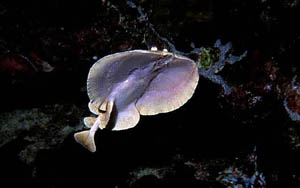 |
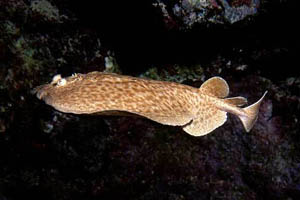 |
p. 26 The unknown Moray eel has been identified by Dr John Randall as Gymnothorax hepaticus.
p. 31 The correct version of the scientific name for the Silverspot Squirrelfish is Sargocentron caudimaculatus
p. 40 The bottom picture identified as the Large Bearded Scorpionfish (Scorpaenopsis oxycephala) is probably simply a large sized Bearded Scorpionfish (S. barbata).
p.49 We now have a photograph of the third blenny that belongs to the Ecsenius frontalis trio which we incorrectly referred to as E. nigrovittatus. Only, things are not as straight forward as they seem. This fish is known by the junior synonym of Salarias nigrovittatus and it has not been conclusively shown as a variant of E. frontalis. Dr Victor Springer who is the authority on these fishes decided to recognise only one species for the three forms, and he tells us that there are two ways to come to a definite conclusion. One is to see if the three species will interbreed and the other is to do a DNA analysis on all three.
|
|
|
Until recently it was thought that S. nigrovittatus is found only in the south of the Red Sea. However, the photograph you see here was taken near Jeddah suggesting that the territories of all three in fact overlap.
p. 50 The picture shown under Istiblennius periophthalmus somehow turned out as an Istiblennius edentulus. The valid name for I. periophthalmus is now Blenniella periophthalmus : B. periophthalmus looks like this:
|
p.55 The juvenile C. melannotus shown is actually the juvenile of C. austriacus - thank you Johnathon Mee !
p.61 The cardinalfish we call A. timorensis is A. guamensis. These two are closely related, but it is the guamensis that sometimes bears 3-4 narrow pale bands as shown in this example.
p.62 What we show as Cheilodipterus lineatus is most likely another Cheilodipterus arabicus. The name Cheilodipterus lineatus is a junior synonym for C. macrodon and is not valid for this species. The middle photo shows narrow lines behind the eye which suggests that this may be a different species, but we are advised that this may be an age factor.
p.76 The juvenile which appears as a Yellowflank Damselfish is most probably the juvenile of the Whitebelly Damselfish below it. Sometimes we see the Yellowflank with strong black markings on its fin edges, and often wonder if there is another species in the genus.
p.81/82 Emperors: these are a headache to identify. Different species can look surprisingly similar in the water and several species can ‘turn on’ a variegated pattern at will. There may well be errors here.
p. 85 The valid scientific name for the Suez Fusilier is Caesio suevica.
p. 87 The valid scientific name for the Long-barbel Goatfish is Parupeneus macronemus.
p. 92 The name of the fish at the bottom of the page is Exyrias belissimus.
p. 93 The Ctenogobiops gobies are mixed up. The top picture which we call C. crocineus actually depicts C. maculosus. We believe that the middle photo shows C. feroculus, and the bottom C. crocineus. But, we are checking - meanwhile, additional photos below, C. crocineus left, C. maculosus right.
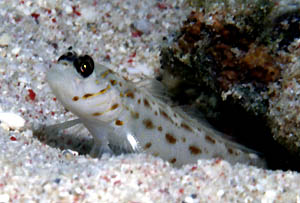 |
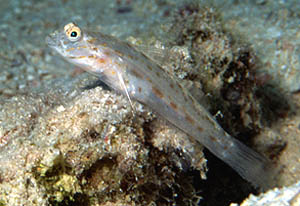 |
p. 94 The top two photos show the same species - Eviota zebrina. E. zebrina appears to be far more common than E. sebreei. They are similar, as shown, E. zebrina left, E sebreei right:
|
|

p. 96 Gobiodon rivulatus may or may not be the valid name for this fish. Dr. Richard Winterbottom explained that there was a mix up in the early 1800's apparently because Rüppel did not designate a holotype. His description of G. rivulatus fits the picture that we show. After Rüppell, Valenciennes described what was presumeably the same fish as G. histrio - so we do not know the correct valid name for this fish.
p.107-109 The valid name for the Striped Anthias is now Anthias taeniatus, vice Pseudanthias taeniatus.
p. 119 The captions of 'intial' and 'terminal male' are reversed
p. 125 Spotted Sandperch - the correct spelling is Parapercis hexophtalma ( not --thalma)
p. 132 The valid scientific name of the Black Surgeonfish has been changed to Acanthurus gahhm.
p. 134 The name Zebrasoma veliferum is used for the Pacific Ocean species. The Indian Ocean species are known as Z. desjardinii (Bennett,1835)
p. 144 The valid scientific name of the Abudjubbe is Cheilinus trilobatus. C. abudjubbe is a junior synonym
p. 146 Dr John Randall proposed that the Red Sea Bird Wrasse be considered as a separate subspecies. However, up to now this has not been ruled as valid. The name should therefore be the same as that of the Indian Ocean population, Gomphosus caeruleus.
p. 151 The scientific name should appear as Oxycheilinus digrammus, the species name beginning with a lower case. Our publisher also seems not to know what is striped and what is not !
p. 154 Here we have a dispute between two long dead scientists – Dr.Eschmeyer lists the valid name for Klunzinger’s Wrasse as Thalassoma rueppellii ie Rüppell’s wrasse, but we still call it Klunzinger's wrasse.
p. 165 The scientific name of the Yellow spotted Burrfish has been changed to Cyclichthys spilostylus.
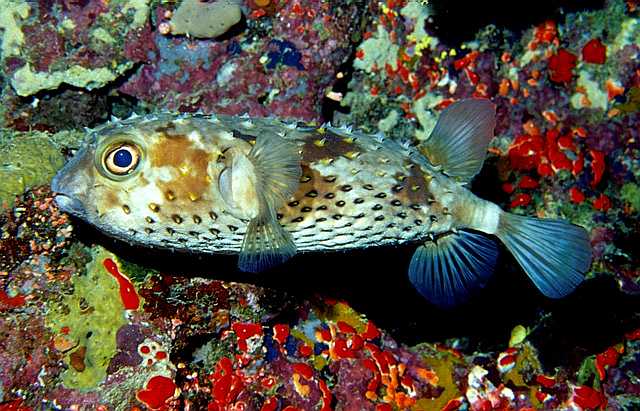
p. 176 Sphyraena putnamiae is incorrect - should be S. putnamae
p. 181/183 The scientific names of the Blacktip Mojarra and the Slenderspine Mojarra are reversed.
Updates
Name Changes -
| Common Name | Invalid Name | Valid Name | Author | Date |
| Blotched fantail stingray | Taeniura melanospilos | Taeniura meyeni | Mueller & Henle | 1841 |
| African coris | Coris africana | Coris cuvieri | Bennett | 1831 |
| Black surgeonfish | Acanthurus nigricans | Acanthurus gahhm | Forsskal | 1775 |
| (no common name) | Atrosalarias fuscus | Atrosalarias fuscus fuscus | Rueppell | 1838 |
| Royal damselfish | Paraglyphidodon melas | Neoglyphidodon melas | Cuvier | 1830 |
Postscript
We are now in a position to publish a similar but much more comprehensive book on the Red Sea fauna, and will try do so within the coming two years. We expect to show more species than have been published before on Red Sea fishes. We shall publish the next book ourselves - the publisher of this book, Kegan Paul, is dishonest and potential sponsors of books (particularly on Arabian subjects) should be very careful when dealing with this company.We as authors, have not heard from them for six years !!).
There is considerable work to be done on Red Sea fishes - there are many undescribed small creatures for ichthyologists to work on, and there are many examples where distribution of species needs updating. We try to help the ichthyologist as a pleasurable pastime, and we discover things more by accident than design ! But, above all, capturing the beauty of these creatures on film to show to all is our objective.